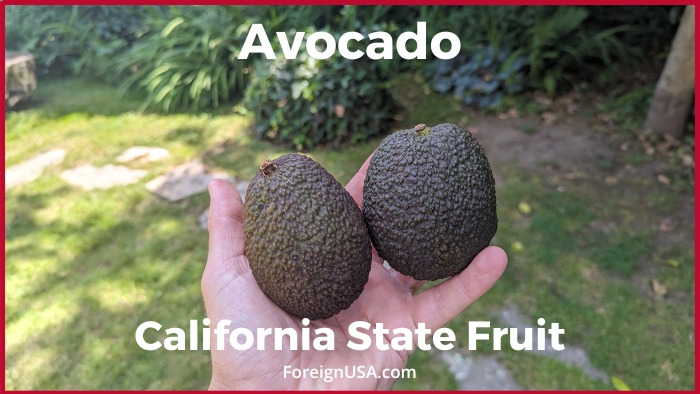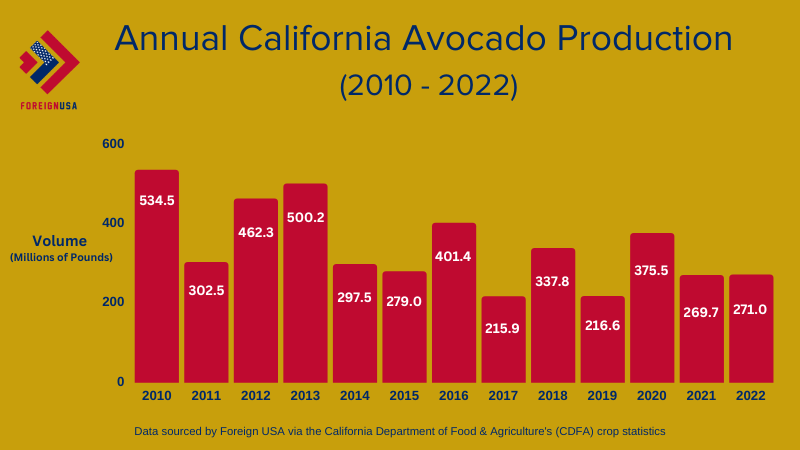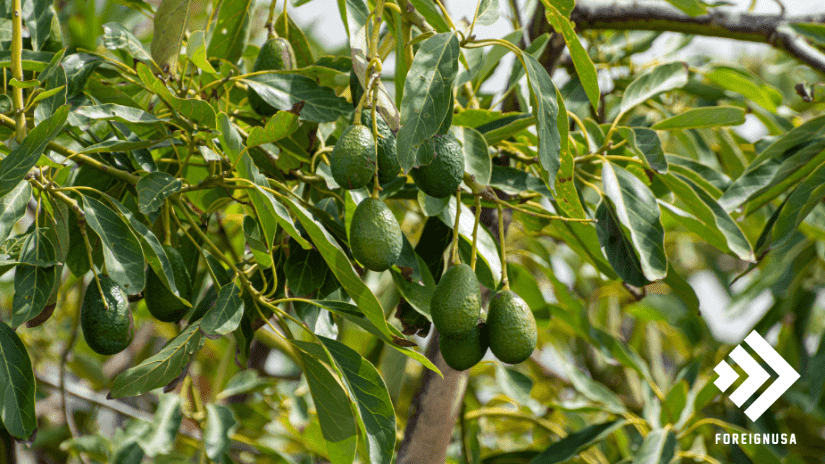State symbols date back as far as the 19th century when states such as California decided to begin adopting their own official state symbols, typically used to best represent the state, past and present.
A state symbol can come in the form of state animals, mammals, a state bird and flower, fruits, vegetables, insects, amphibians, nicknames, state seals, and much more.
State symbols were adopted by states to best represent them and their historical roots and past and present successes. Like all other states, there are many California state symbols.

What is the State Fruit of California?
The unofficial California state fruit is avocado. Despite not officially having a fruit that represents the state of California, there is an “unofficial” state fruit that is recognized to best showcase the state, which is the incredibly popular avocado fruit.
California produces the majority of fruits and vegetables in the United States. Many believe this is due to the incredibly consistent weather, making for perfect growing conditions, especially with tropical fruits such as avocado.
The confusion that comes with avocados is that they are actually classified as a vegetable in the USDA database based on their usage.
However, they are considered a fruit because they match the criteria for berries due to their pulp and large seed residing in the middle. They belong to the fruit genus Persea and the Lauraceae family.

Funnily enough, avocados were once considered a “royal food”, only being used and eaten by the rich and famous, or royalty of this world. Nowadays, avocados are one of the most commonly eaten fruits, containing many nutrients and natural fats, super healthy and tasty.
By now, it is no secret that the majority of the avocados produced in the United States are grown in the Golden State.
Here are some recent statistics for avocados in California:
- In 2020 (the 2019 to 2020 growing season), the number of avocados produced in California was 375.5 million pounds.
- In 2021 (2020 to 2021 growing season), there was a decrease in the number of avocados produced by the Golden State, with only 269.7 million pounds produced throughout the year.
- In 2022 (2021 to 2022 growing season) alone, around 271 million pounds of avocados were grown and harvested in California!
The table below delves deeper into the avocado production statistics in the Golden State of California. The table charts the data since 2010 and shows the annual volume of avocados produced by weight and their total crop value:
| Year | Volume by Weight Produced | Crop Value | Growing Season |
|---|---|---|---|
| 2022 | 271.0 million pounds | $327,369,000 | 2021 to 2022 |
| 2021 | 269.7 million pounds | $327,605,005 | 2020 to 2021 |
| 2020 | 375.5 million pounds | $411,490,578 | 2019 to 2020 |
| 2019 | 216.6 million pounds | $372,285,783 | 2018 to 2019 |
| 2018 | 337.8 million pounds | $383,129,253 | 2017 to 2018 |
| 2017 | 215.9 million pounds | $345,875,896 | 2016 to 2017 |
| 2016 | 401.4 million pounds | $412,332,493 | 2015 to 2016 |
| 2015 | 279.0 million pounds | $303,160,400 | 2014 to 2015 |
| 2014 | 297.5 million pounds | $333,216,563 | 2013 to 2014 |
| 2013 | 500.2 million pounds | $435,023,142 | 2012 to 2013 |
| 2012 | 462.3 million pounds | $381,852,467 | 2011 to 2012 |
| 2011 | 302.5 million pounds | $460,209,682 | 2010 to 2011 |
| 2010 | 534.5 million pounds | $402,770,893 | 2009 to 2010 |
We have created a graph below to display the California state fruit (avocado) production over the past 10+ years, dating all the way back to 2010:

It is believed that there are actually more than 500 different varieties of avocado, with the most popular being Hass, which contains the best flavor and is the most commonly sold for consumption. 95% of avocados produced are the very popular Hass variant.
Most of the California avocados are harvested on around 50,000 acres of land, from Monterey all the way through to San Diego by around 3,000 growers in total. Both Ventura and San Diego are the top avocado-producing counties in the state.
Something a lot of people do not know about avocados is that they are grown all year round, with a single tree producing up to 200 pounds of fresh avocados each year, which accounts for roughly 500 pieces of fruit!
The Hispanic influence on California and many other states in the U.S. has massively played a part in the way we consume avocado too. Obviously, there is the classic way, slicing up the fruit and eating it on toast or whatever your heart desires.
However, one of the most popular ways to eat avocados in Mexico is by pureeing it into something called guacamole! Guacamole, or “guac” is used as either a spread, dip, or even a sauce for many Mexican-based meals, such as tacos, burritos, fajitas, nachos, and many more!
History of Avocados in California and Their Present Day Popularity
Now that we have looked into avocado production in California, let’s take a look at the weird and wonderful history of these unique fruits.
Avocados were originally founded and grown in South-Central Mexico, around the time between 7,000 and 5,000 B.C., but it was far later on that the wild variants were cultivated.
In fact, it was in 1696 when the first English-language mention of the word “avocado” was used! Despite this, English speakers still often referred to the fruit as “Alligator Pear”.

During the year 1914, two fruit growers traveled to the Grand Central Market, located in downtown Los Angeles to purchase one of the notorious new fruits named “Alligator Pear”.
These fruits weren’t cheap at all, costing $1 each, which, at the time, was seen to be a large amount of money.
Eager to see what all the fuss was about, the two growers sliced open the fruit, which was unripe at the time, and took an underwhelming bite. They moved on and didn’t try one again for several years.
A third-generation avocado grower and the grandson of one of the fruit growers stated; “it was 20 years before my grandfather looked at one again”. Nowadays, the grandson, Rick Shade, owns part of a 200-acre avocado grove, and hosts an annual Avocado Festival in October!
He states, “We can’t keep up with the demand. The world wants avocados.”, and he’s not wrong! There are a couple of key factors as to why avocados have become such a popular food not just in the United States, but globally too.
One of these reasons is due to the ban on imported avocados from Mexico being loosened, as Mexico is the biggest producer of the fruit. Secondly, they are a staple in Hispanic food culture, especially when it comes to guacamole.
California is not just the largest producer of avocados in the U.S., it is the largest consumer too, which does make sense. The most popular type of avocado in the Golden State is the “Hass” variant.
Hass avocados are so popular because they are durable and have a long shelf life, which makes them ideal for shipping internally and internationally.

Despite many people not realizing that avocado is a fruit, it has surely become one of, if not the most mainstream and popular fruits of recent times.
Final Thoughts on Avocados in California
Most states will have their symbols showcase a relevant story indicative of the state and its history, and the Golden State puts its history and what it stands for across very well in the California state Fruit.
This interesting fact about California and a whole host of others, like the state insect of California, is what makes the state so unique and fascinating to those who live there or are researching the historical events of the state.


